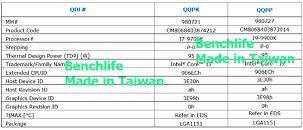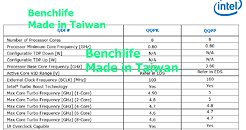Tuesday, August 14th 2018

Finer Details of Intel Core i7-9700K and Core i9-9900K Emerge
Taiwanese tech site BenchLife.info scored finer details of Intel's upcoming premium LGA1151 processors through screenshots of leaked documents; revealing more about the Core i7-9700K 8-core/8-thread processor, and the top-dog 8-core/16-thread Core i9-9900K. The i7-9700K has the QDF number QQPK, and the i9-9900K "QQPP." The tables below also reveal their extended product code, CPUID, and iGPU device ID. There's also a confirmation that the TDP of both parts is rated at just 95 W. The next table provides a great insight to the clock speeds of the two chips.
Both chips idle at 800 MHz, and have an identical nominal clock speed of 3.60 GHz. The two differ with their Turbo Boost states. The i7-9700K has a maximum Turbo Boost state of 4.90 GHz, which it awards to 1-core. As a reminder, this chip is the first Core i7 SKU ever to lack HyperThreading support. 2-core boost frequency for this chip is 4.80 GHz. 4-core boost is up to 4.70 GHz. 4.60 GHz is the all-core boost (cores 5 thru 8). The i9-9900K gives both 1-core and 2-core the highest boost frequency of 5.00 GHz (that's up to 4 threads). The 4-core boost state is 4.80 GHz, and all-core (cores 5 thru 8) get 4.70 GHz. Intel is keeping its boost states rather high for this round of processors, as it tries to compete with the Ryzen 7 "Pinnacle Ridge" series.
Source:
BenchLife.info
Both chips idle at 800 MHz, and have an identical nominal clock speed of 3.60 GHz. The two differ with their Turbo Boost states. The i7-9700K has a maximum Turbo Boost state of 4.90 GHz, which it awards to 1-core. As a reminder, this chip is the first Core i7 SKU ever to lack HyperThreading support. 2-core boost frequency for this chip is 4.80 GHz. 4-core boost is up to 4.70 GHz. 4.60 GHz is the all-core boost (cores 5 thru 8). The i9-9900K gives both 1-core and 2-core the highest boost frequency of 5.00 GHz (that's up to 4 threads). The 4-core boost state is 4.80 GHz, and all-core (cores 5 thru 8) get 4.70 GHz. Intel is keeping its boost states rather high for this round of processors, as it tries to compete with the Ryzen 7 "Pinnacle Ridge" series.


48 Comments on Finer Details of Intel Core i7-9700K and Core i9-9900K Emerge
On another note, couldn't BenchLife use a slightly less glaring "watermark" (more like a stamp) than neon green? Honestly, it's somewhat annoying...
The real surprise here will be whether these are soldered or not. Considering der8auer's very strong hints a while ago, I'm leaning towards thinking Intel aren't quite dumb enough to smear these with their bird-poop TIM.
because, that's EXACTLY how it feels to buy Intel nowadays. You are STUCK with 100 years old, minorly polished old tech, and NO ONE is progressing us into V6, V8, higher horse power or better fuel efficiency and that is all right ???
Ironically, most of the "Intel has been screwing us for years" posts claim that the way they've been "screwing us" is by releasing new improvements at "only" 5-10% faster per generation, as if they "held back tons of performance they could have given us, if they weren't so greedy". So this gives them too much credit for innovation, and no credit at all for good business sense, keeping their upgrades linear to avoid making their own products obsolete. Go figure...